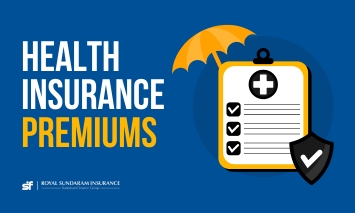Health Insurance Premiums
Mar 24, 2025 • 3 Min Read
Health insurance is one of the most critical elements in one’s financial planning, as it comes with a fixed monthly or annual premium that policyholders have to account for to keep their insurance coverage active. Understanding your health insurance premium is important in selecting the best plan that suits your needs, while not creating a burden on your expenses.
The right selection helps you stay insured and plan for your emergency medical costs. This article aims to explain the influence that insurance premiums play in your overall budgeting responsibilities, while explaining some disparities amongst varying costs.
Key Factors Affecting Premiums
Age
Healthcare is more probable for older individuals than younger people as they usually have more medical needs with a higher associated risk. This means that their coverage will cost you more than their younger counterparts.
Health Status
Insurers may adapt premiums to reflect your health status. Buyers with any pre-existing or chronic diseases have to pay higher premiums than others.
Location
Premiums may also vary across different regions due to healthcare costs, which means you are subjected to pay premiums depending on where you reside. Urban areas are usually associated with higher medical expenses, which, in turn, cause patient insurance rates to increase.
Coverage Level
The choice of your plan is subject to variable pricing. These depend on the coverages and facilities being provided.
Tobacco Use
If you have an active smoking tendency, you are likely to pay a much higher premium because the health risks of smoking are greater than those related to non-smokers.
Family Size
Family covers have multiple recipients, where premiums increase with the number of people using the plan
Insurance Company
While insurance companies set up their respective pricing formulas, there is a fundamental disparity that results in a wide range of varying premiums in the market even though they offer equivalent coverage.
Comparing Plans and Pricing
- Premium vs. Coverage: You must assess the level of health insurance monthly premium and the degree of coverage it provides. Low-premium health insurance programs may have high out-of-the-pocket costs, while high premiums are more compensatory.
- Deductibles and Co-payments: You must be familiar with each plan's deductible amount, co-payment and co-insurance. The risk-adjusted models may have the highest deductible and so, higher expenses for medical services.
- Network Providers: Ensure that the plan you have chosen includes your healthcare providers in their coverage network. Paying in-network providers allows lower costs that are otherwise not covered.
- Prescription Drug Coverage: Read through the coverage drug prescription to understand the co-payment rates for your medications.
- Annual Maximums: You may have an out-of-pocket maximum amount in the plan, which sets the quota of what is due for covered services in a year. Plans with higher premiums will have a small out-of-pocket maximum. This might work for some people, while others might not be comfortable.
Tips for Lowering Premiums
Choose a Higher Deductible
This type of plan periodically allows for a choice between low-premium health insurance and a higher deductible. On the other hand, the initial stage of a deductible means you can prepare to pay out-of-pocket money for the medicine until you reach your specified limits.
Explore Health Savings Accounts (HSAs)
HSAs provide a good balance to make tax-deductible contributions while covering your medications and hospital treatments. One of the primary benefits of enrolling in plans with high deductibles, while pairing it with an HSA, is that it will have lower premiums and potential tax-saving advantages.
Shop Around
Find the best package for your needs by shopping around different insurance companies. As with online marketplaces and insurance brokers, you can explore the various options and prices.
Take Advantage of Wellness Programs
Healthy individuals enjoy certain benefits, such as wellness programs and incentives offered by insurance companies, like bike riding and tobacco smoke cessation. Getting involved in these programs could help people obtain lower insurance premiums.
Understanding Policy Terms
- Premium: Premium is the fee you pay every month to the health insurance company.
- Deductible: The portion of covered services costs that you must pay before the insurance company pays for the remaining amount based on the coverage.
- Co-payment: A fixed amount is mainly charged for covered services such as doctor visits and listed medications.
- Co-insurance: The percentage of expenses you must pay by the end of the schedule after reaching the limit.
- Out-of-Pocket Maximum: The biggest financial expenditures people may have to put in annually include covered services such as deductibles, co-payments and co-insurance. When the deductible weight is reached, the insurance starts covering 100% of the included services as per the coverage.
Conclusion
Health insurance premiums have a huge impact on the cost and the inclusiveness of healthcare coverage. When selecting the right plan, you should attain knowledge of the essential points determining the premiums, comparisons, policy terms and various pricing options to choose from. Ensuring that the care provided covers essential needs for each person and keeps costs in check is one of the key ways of keeping yourself out of poverty and financial stress due to health-related difficulties. Consider exploring options with Royal Sundaram for comprehensive health insurance coverage and competitive premiums, ensuring both your health and financial well-being.



Discover the perfect insurance plan for you!
Get your free quote now!
Get StartedBy Clicking on Get Started, You agree to our Terms and Conditions and override DNC/NDNC registration.
More like this
View more





